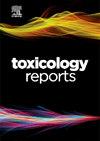Modulation of the effects of a cholesterol-supplemented high-fat diet by aryl hydrocarbon receptor (AHR) activation and/or tryptophan reduction in male mice
Q1 Environmental Science
引用次数: 0
Abstract
Aryl hydrocarbon receptor (AHR) is a ligand-activated transcription factor whose role in energy metabolism is obscure. Most of its physiological ligands are derived from tryptophan (TRP). Here, fifty male C57BL/6JRccHsd mice were assigned to one of five feeding groups, control diet (CD), high-fat diet (HFD; 45 % of energy from fat), HFD with only 70 % of the regular TRP concentration (HFDtrp), HFD supplemented with a weakly toxic AHR agonist C2 (HFDc2), or HFDtrp with C2 (HFDtrp-c2). All diets contained 2 % cholesterol and were fed for 18 weeks. On weeks 14–16, the mice were tested for gas exchange and locomotor activity, and on weeks 15–17 for glucose tolerance (GTT) and insulin sensitivity (ITT). At termination, tissue samples were collected for biochemical and AI-assisted histological analyses. Body weight gain (BWG) was only 28–38 % higher in the HFD groups than in the CD group, but the HFD-fed mice accumulated 43–61 % more fat. Calorie intake was greater in the two low-TRP groups than in the two other HFD groups, while BWG remained similar. C2 induced Cyp1a1 expression (an index of AHR activity) in all tissues examined and increased the ratio of micro-/macrosteatosis in the liver. The HFDs tended to reduce insulin sensitivity, CO2 production, and the ability to respond appropriately to a low-temperature challenge. These findings suggest that the effects of AHR activity modulation on energy balance are strongly context-dependent. A sensitive response to long-term AHR activation appears to be elevated micro-/macrosteatosis ratio in the liver when exposed to HFD.
雄性小鼠芳烃受体(AHR)激活和/或色氨酸减少对胆固醇补充高脂肪饮食影响的调节
芳烃受体(AHR)是一种配体激活的转录因子,其在能量代谢中的作用尚不清楚。其大部分生理配体来源于色氨酸(TRP)。实验中,50只雄性C57BL/6JRccHsd小鼠被分为5个喂养组:对照组(CD)、高脂饲粮(HFD);45 %的能量来自脂肪),HFD仅含有常规TRP浓度的70 % (HFDtrp), HFD补充弱毒性AHR激动剂C2 (HFDc2),或HFDtrp与C2 (HFDtrp- C2)。饲粮中胆固醇含量为2 %,饲喂18周。在14-16周,小鼠进行气体交换和运动活动测试,在15-17周进行葡萄糖耐量(GTT)和胰岛素敏感性(ITT)测试。终止时,收集组织样本进行生化和人工智能辅助的组织学分析。HFD组的体重增加(BWG)仅比CD组高28-38 %,但HFD喂养的小鼠积累的脂肪多43-61 %。两个低trp组的卡路里摄入量高于其他两个HFD组,而BWG保持相似。C2在所有被检查的组织中诱导Cyp1a1表达(AHR活性指数),并增加肝脏中微/大脂肪变性的比例。HFDs倾向于降低胰岛素敏感性、二氧化碳产量和对低温挑战的适当反应能力。这些发现表明,AHR活动调节对能量平衡的影响强烈依赖于环境。当暴露于HFD时,对长期AHR激活的敏感反应似乎是肝脏微/大脂肪变性比率升高。
本文章由计算机程序翻译,如有差异,请以英文原文为准。
求助全文
约1分钟内获得全文
求助全文
来源期刊

Toxicology Reports
Environmental Science-Health, Toxicology and Mutagenesis
CiteScore
7.60
自引率
0.00%
发文量
228
审稿时长
11 weeks
 求助内容:
求助内容: 应助结果提醒方式:
应助结果提醒方式:


